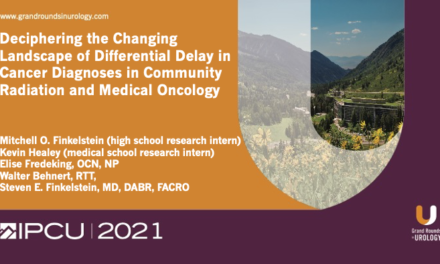
PCa Commentary | Volume 171 – November 2022
Posted by Edward Weber | November 2022
Nonmetastatic Castration-Resistant Prostate Cancer: The “Ides” of Androgen Receptor Inhibition — Enzalutamide, Apalutamide and Darolutamide.
Nonmetastatic castration-resistant prostate cancer (nmCRPC) is a transient, heterogeneous state that progresses to metastatic disease. nmCRPC is defined as a rising PSA after primary therapy in association with a castrate level of testosterone (<50 ng/mL) while negative for metastases on conventional imaging with CT and technetium bone scans. “Among nonmetastatic CRPC men, nearly 60% developed metastases during the 5 years, with most of the metastases occurring within the first 3 years,” (Moreira et al., UROLOGY 2016). Factors that suggest a more rapid progression to the metastatic state are “younger age, high Gleason score (>7), high prostate specific antigen levels, reduced prostate-specific antigen doubling time (<6 months), and a rapid alkaline phosphatase rise” (Figueiredo et al., (Clin Drug Investigation. 2022)
Three major randomized trials addressed this condition — PROSPER, ARAMIS and SPARTAN in which enzalutamide, apalutamide or darolutamide, respectively, each combined with Lupron were compared with Lupron alone. In each the study participants were at high risk for disease progression: Gleason Score >8 with a rapid PSA doubling time of < 10 months. Metastases free survival (MFS) was the chosen endpoint since it has been validated as a surrogate for overall survival. In each trial the study drug + Lupron significantly outperformed Lupron alone.
Comparison of Trial Results:
Understandably, there is strong interest in identifying the “best” regimen for treating nonmetastatic CRPC, but there have not been ‘head-to-head” comparisons among the drugs to answer that question. The most instructive reviews are Figueiredo (ibid) and Cattrini et al., Cancers(Basel). Both analyzed the three landmark trials comparing outcomes and safely profiles, and suggested features that might assist in individualizing the choice of a drug for a particular patient. This Commentary will review Figueiredo’s study.
Figueiredo’s Triple Comparison:
The median MFSs in the PROSPER, ARAMIS and SPARTAN trials were essentially similar: 36.6, 40.4 and 40.5 months, respectively in these men who were at high risk of progression: PSADT <10 month and PSA levels >2 ng/mL.
The profiles of adverse effects differ among the three drugs and may serve as the basis for an individualized choice.
The chemical structures of apalutamide and enzalutamide are nearly identical, which may explain the similarity of side effects between them. “Both agents are associated with a higher incidence of falls, fatigue, hypertension, rashes and seizures compared to” ADT, and “have the potential for pharmacological interaction with other medications … .”(ibid)
Darolutamide has a distinctly different chemical structure and, compared to enzalutamide and apalutamide, has only minimal penetration of the blood brain barrier. This may account for comparatively lesser adverse effects than enzalutamide or apalutamide. Darolutamide showed limited potential for clinically relevant drug interactions.
As collated from five references by Crawford, adverse effects of darolutamide were comparatively less than the other two drugs: fatigue, 15.8%; falls, 4.2%; dizziness, 4.5%; seizures, 0.2%; hypertension, 6.6%; diarrhea, 6.9%; and rash 2.9% (Crawford et al., Cancer Management Res, 2020.)
In short, Figueiredo’s and Cattrini’s meta-analyses both reported that apalutamide (and to a lesser extent enzalutamide) were more effective than darolutamide, but darolutamide was better tolerated. However, in each the study drug plus Lupron significantly prolonged MFS and overall survival compared to Lupron alone.
- Important: A Caveat: In each of the three trials the determination of “nonmetastatic” was based on conventional CT and technetium bone scans. Fender et al., Clin Cancer Research, (2019) addressed this issue in “Prostate Specific Membrane Antigen Ligand Positron Emission Tomography in Men with Nonmetastatic Castration-Resistance Prostate Cancer.” Their work suggests that because of the insensitivity of conventional imaging to detect small size metastases the outcomes of the three major trials should be regarded as studies of patients with low-burden metastatic disease and not metastases-free.
Fender et. al., base this observation on their study of 200 men with nmCRPC. Similar to the men in the major trials, the men in the Fender study also had prostate-specific antigens (PSA) >2 ng/mL and high risk for metastatic disease [i.e., PSA doubling time <10 months and/or Gleason score of > 8].
Their findings: “PSMA-PET in 200 patients found metastatic disease in 55% despite negative conventional imaging. The metastatic disease was located in extrapelvic nodes, 39.5%; in bone, 24% and in visceral organs in 6% of patients. Overall, 44% had disease in the pelvis, including 24% with local prostrate bed recurrence. 46% had >4 metastatic lesions.
Treatment of nmCRPC – The Need for Data Driven Guidance:
Although PSMA/PET imagining finds that there is substantial low-burden metastatic disease in men assigned nmCRPC based on conventional imaging, data is lacking demonstrating that treatment based on PSMA PET imaging prolongs survival.
Figueiredo, acknowledging this lack, wrote: “Nevertheless, considering the lack of clinical trials assessing the prognosis of patients with metastases detected only by PSMA, further investigation is warranted to determine whether PSMA PET/CT should be extensively used in high-risk nmCRPC patients.” Data is required to establish that early treatment in this PSMA imaged group results in a survival benefit compared to the outcomes reported in the three major trials.
Of note: Cattrini (ibid) points [as of 4/2020] “Neither apalutamide nor darolutamide can be used in metastatic CRPC, and a therapeutic opportunity may be lost in patients who are immediately upstaged from nmCRPC to metastatic. Hussain et al., (JCO. 2022) states that “until data provides better guidance …clinicians should base treatment decisions [in men with nmCRPC] on the extent of disease seen on conventional imaging.”
However, it should also be noted that if a patient with “nmCRPC” based on conventional imaging were found to have metastatic cancer on PSMA PET, he would be eligible for Provenge and metastases directed therapy.
BOTTOM LINE:
Treatment regimens combining enzalutamide, apalutamide or darolutamide with androgen deprivation have been found equivalent in prolonging metastases-free and overall survival in men with nmCRPC who are at high risk for recurrence compared to ADT alone. PSMA/PET imagining finds that there is substantial low-burden metastatic disease found in men assigned nmCRPC based on conventional imaging. More data is needed to incorporate this fact into treatment
Your comments and requests for information on a specific topic are welcome e-mail ecweber@nwlink.com.
Please also visit https://prostatecancerfree.org/prostate-cancer-news for a selection of past issues of the PCa Commentary covering a variety of topics.
“I want to thank Dawn Scott, Staffperson, Tumor Institute Radiation Oncology Group, and Mike Scully, Librarian, Swedish Medical Center, for their unfailing, timely, and resourceful support of the Commentary project. Without their help this Commentary would not be possible.”
ABOUT THE AUTHOR
Edward Weber, MD, is a retired medical oncologist living in Seattle, Washington. He was born and raised in a suburb of Reading, Pennsylvania. After graduating from Princeton University in 1956 with a BA in History, Dr. Weber attended medical school at the University of Pennsylvania. His internship training took place at the University of Vermont in Burlington.
A tour of service as a Naval Flight Surgeon positioned him on Whidbey Island, Washington, and this introduction to the Pacific Northwest ultimately proved irresistible. Following naval service, he received postgraduate training in internal medicine in Philadelphia at the Pennsylvania Hospital and then pursued a fellowship in hematology and oncology at the University of Washington.
His career in medical oncology was at the Tumor Institute of the Swedish Hospital in Seattle where his practice focused largely on the treatment of patients experiencing lung, breast, colon, and genitourinary cancer and malignant lymphoma.
Toward the end of his career, he developed a particular concentration on the treatment of prostate cancer. Since retirement in 2002, he has authored the PCa Commentary, published by the Prostate Cancer Treatment Research Foundation, an analysis of new developments in the prostate cancer field with essays discussing and evaluating treatment management options in this disease. He is a regular speaker at various prostate cancer support groups around Seattle.




